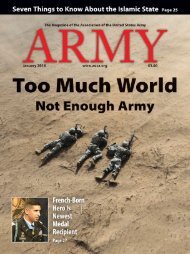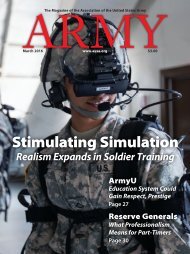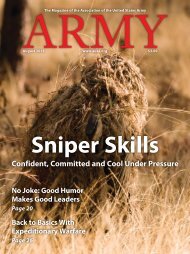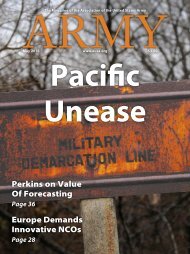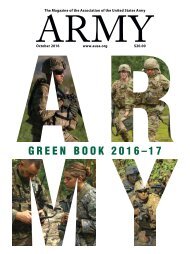Army - Kicking Tires On Jltv
Create successful ePaper yourself
Turn your PDF publications into a flip-book with our unique Google optimized e-Paper software.
U.S. <strong>Army</strong>/Sgt. Gemma Iglesias<br />
Above: Soldiers from African nations visit the<br />
Joint Multinational Readiness Center in Hohenfels,<br />
Germany; left: Soldiers from the 173rd<br />
Airborne Brigade demonstrate room-clearing<br />
techniques to Ukrainian troops in Ukraine.<br />
U.S. <strong>Army</strong>/Spc. Joshua Leonard<br />
For <strong>Army</strong> units involved in RAF, the devotion to a particular<br />
region helps provide purpose for home-station training, ensuring<br />
that they focus on what combatant commanders want. With<br />
“engagement” now listed as one of the <strong>Army</strong>’s warfighting functions<br />
and “shaping the security environment” counted among<br />
the core competencies of the <strong>Army</strong>, the security cooperation nature<br />
of many RAF-executed deployments demonstrates that a<br />
unit’s participation in RAF can directly contribute to its preparedness<br />
to execute some of the <strong>Army</strong>’s core missions.<br />
Prepare for Domination<br />
Several RAF activities to build partner capacity were conducted<br />
alongside special operations forces with long experience<br />
in the region, with general purpose and special operations forces<br />
complementing each other’s capabilities. All of this prepares<br />
units to dominate the human domain, as ground forces are<br />
called upon to do. Small-unit, geographically distributed expeditionary<br />
missions also provide excellent leadership and command<br />
opportunities, and force the exercise<br />
of Mission Command at a time<br />
when situational awareness tools seem to<br />
allow this prerogative of effective operations<br />
to be a popular theme that is often<br />
ignored in practice.<br />
Despite these clear successes, criticisms<br />
of the RAF concept remain, and some of<br />
them are valid. The concern that implementation<br />
would be too costly to the<br />
<strong>Army</strong> has been shown to be largely unfounded,<br />
as many RAF-executed activities<br />
are financed with Title 22 (Department<br />
of State) funding for activities<br />
related to building partner capacity, or through exercise-related<br />
funds. This money would be spent anyway, regardless of which<br />
unit participated in the exercise.<br />
There is, however, an opportunity cost for a unit involved in<br />
RAF. For example, time spent on learning to use a foreign<br />
weapon for an activity related to building partner capacity is<br />
time that is not spent conducting battle drills. Some 20 years<br />
ago, soldiers participating in peacekeeping missions in Bosnia<br />
developed the small-unit leadership skills and attributes that<br />
proved to be essential in operations in Afghanistan over the<br />
last 15 years. We should expect similar intangible benefits and<br />
training offset from soldiers conducting activities that are new<br />
to them in regions they do not know well today.<br />
Some of the more common criticisms of the RAF concept are<br />
related to its definition and why it’s important. Since its inception,<br />
RAF has meant different things to different people: a new<br />
focus on building partner capacity, to some soldiers; predictable<br />
availability of troops, to geographic combatant commands; per-<br />
February 2016 ■ ARMY 33




